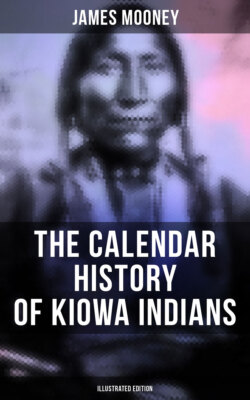Читать книгу The Calendar History of Kiowa Indians (Illustrated Edition) - James Mooney - Страница 25
На сайте Литреса книга снята с продажи.
Recollections of Other Northern Tribes
ОглавлениеTable of Contents
The old men who have most knowledge of this northern residence and alliance with the Crows and Arikara say, after the Indian style of chronology, that it was in the time when their grandfathers were young men, and when they still had but few horses and commonly used dogs as pack animals in traveling. One of the mythic legends of the tribe accounts for the origin of the Black Hills (Sádalkañi K`op, "manifold mountains"), and another deals with the noted Bear Lodge or Devil's Tower (Tsó-aí, "tree rock," i. e., monument rock), near Sun Dance, Wyoming, which they claim is within their old country. Beyond the Yellowstone (Tsósâ P'a) they say lived the Blackfeet (Tóñkóñko, "blackleg people") and the Arapaho Gros Ventres (Botk`iägo, "belly people"). They knew also the Shoshoni (Sondóta, "grass houses"), who, they say, formerly lived in houses of interwoven rushes or grass; the Flatheads, the northern Arapaho, and of course the Dakota. It is somewhat remarkable that they knew also the small tribe of Sarsi, living on the Canadian side of the line at the source of the North Saskatchewan, whom they describe accurately as a tribe living with the Blackfeet and speaking a language resembling that of the Apache. They call them Pák`iägo, which they render "stupid people," indicating the tribe in the sign language by a sweeping motion of the right hand across the thigh, perhaps from a confusion with paki, thigh. It is possible that the name is not really of Kiowa origin, but is derived from Päki or Päkiani, the Shoshoni name for the Blackfeet themselves. The Kiowa call the Brulé Dakota Pakí-gudălkantă, "red-burnt thigh" people, with the same gesture sign as for the Sarsi. Several prominent men of the Kiowa tribe, among whom may be mentioned Gaápiatañ and Pá-tádal, are of Sarsi descent. The maternal grandmother of the noted chief Setäñgya, killed at Fort Sill in 1871, was a Sarsi woman who married a Kiowa man during an interchange of friendly visits between the two tribes. By reason of this Athapascan blood, those of Sarsi descent, including Gaápiatañ, who is Setäñgya's nephew, consider themselves in a measure related to the Kiowa Apache.
From the beginning the Kiowa say that they were usually on friendly terms with the Crows, Arapaho, Arikara, Mandan, and Hidatsa, and, so far as they can recollect, with the Shoshoni and Flatheads, the friendship being interrupted, however, by occasional quarrels more or less serious. They were frequently at war with the Cheyenne, and always, from their first acquaintance, with the Dakota, Pawnee, and Ute. Their relations with the southern tribes will be noted hereafter.
